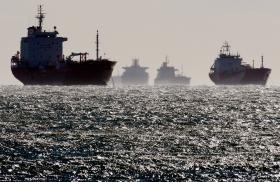At 2:35 a.m. Baghdad time, allied aircraft initiated the first phase of what will probably be a prolonged and intense air campaign against Iraq. Up to 1000 U.S. and 200 allied combat aircraft may have participated in the initial strike. In all, nearly 1700 allied aircraft are in theater, versus 650 Iraqi combat aircraft.
The air campaign exploits allied preponderance in the air to achieve select objectives, and pave the way for subsequent ground operations. It will probably consist of two phases. The first phase -- the strategic air campaign -- began with massive around-the-clock air strikes against targets throughout Iraq. Its purpose:
• Achieve air superiority over Iraq to permit unrestricted freedom of action for allied air power, by destroying the Iraqi air force, suppressing its air defenses, and disrupting its command, control, and communications to prevent a coordinated response.
• Destroy its strategic weapons capabilities, including nuclear, biological, and chemical weapon production facilities, storage sites, and delivery means.
• Destroy as much of Iraq's ground forces as possible. Primary targets are units which comprise the backbone of its offensive ground capability: its 6-8 Republican Guard Divisions, its 10 armored and mechanized infantry divisions, and other armor, artillery, and engineer assets.
Initial Results
The U.S.-led coalition apparently achieved complete surprise. During the first 14 hours of operations, U.S. aircraft reportedly flew 1000 sorties against various targets, including the Iraqi defense ministry, air bases, air defense sites, command, control, and communications facilities, surface-to-surface missile (SSM) launchers, and unconventional weapons production facilities. Approximately 80 percent of all aircraft succeeded in hitting their intended targets. U.S. forces suffered one aircraft lost. More specifically:
• The response of Iraqi air defenses was weak and uncoordinated, apparently reflecting the shock of surprise, and the success of efforts to disrupt command and control capabilities.
• U.S. and allied air power was apparently able to destroy or neutralize Iraq's surface-to-air missiles. Its more than 4,000 anti-aircraft guns have been largely ineffective.
• Most of Iraq's first line aircraft, which are located at air bases equipped with hardened aircraft shelters, probably escaped destruction during the strikes. These air bases were attacked with runway cratering munitions, temporarily neutralizing them. It is possible, however, that older aircraft which may have been dispersed to secondary airfields and highway landing strips, were destroyed.
• Nearly all of Iraq's static SSM launchers have been destroyed, probably by Tomahawk cruise missiles. Some mobile SSM launchers, however, have probably evaded detection and initial attempts to destroy them. As a result, Iraq retains the capability to launch missiles against allied targets.
• Research facilities related to Iraq's nuclear weapons program have reportedly been destroyed. It is not clear, however, what long-term effect this will have on the program, since it is unknown whether Iraq's small stocks of enriched uranium, or all the components of its nascent, relatively undeveloped nuclear infrastructure have been destroyed.
• Iraq's chemical and biological weapon production facilities have reportedly been destroyed. However, at least some of its chemical and biological agent stockpiles -- which are kept at several hardened underground storage sites -- are likely to survive the fighting. Iraq will thus probably retain at least a limited unconventional warfare capability.
• Iraqi armor in southern Iraq and Kuwait, particularly the elite Republican Guard, have been subjected to prolonged, intense aerial bombardment and attempts to interdict their supply lines. These units are dug in, however, limiting their vulnerability to air attack. And although a significant part of Iraq's armor might survive such punishment, it might batter or break morale in some units, while interdiction efforts might limit their ability to resist.
The U.S. hopes that Saddam Hussein will withdraw from Kuwait as a result of a successful air campaign, obviating the need for large-scale ground combat. Meanwhile, the allied aerial campaign will continue for as long as it takes to destroy Iraq's ground forces in Kuwait, or until it becomes clear that air strikes are unable to achieve this objective. In this case, the U.S. is likely to initiate the second phase of the war: large scale ground operations supported by air power in interdiction and support roles. The goal will be to defeat Iraqi ground forces in detail by preventing reinforcements from reaching Kuwait, hindering resupply efforts, and destroying its ground forces.
Outlook
Despite the spectacular achievements of U.S. and allied air forces, much of Iraq's air force remains intact, and at least some mobile SSMs remain at large. Consequently, a sustained aerial campaign lasting a week or more may be required in order to achieve air superiority and destroy remaining SSMs. In addition, because of the limitations of air power against dugin ground forces, it is likely that the U.S. will eventually have to initiate ground operations to achieve its objective of destroying Iraqi ground forces and expelling them from Kuwait. Finally, Iraq is likely to emerge from this war with at least some of its unconventional warfare capabilities intact. Nonetheless, the U.S. could not have hoped for a more successful start for Operation Desert Storm.
Michael Eisenstadt is a research fellow in political-military affairs at The Washington Institute. He is author of the Institute study The Sword of the Arabs: Iraq's Strategic Weapons (Policy Paper #21, 1990).
Policy #58



